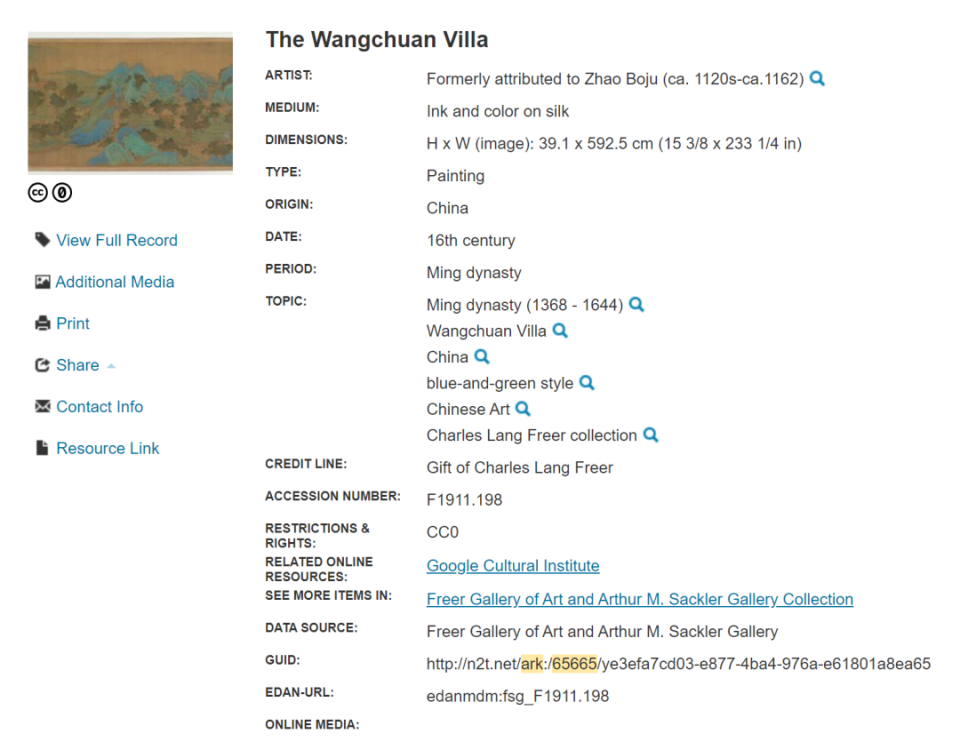此卷是藏于弗利尔美术馆的一卷大青绿设色的《辋川图》摹本,官网标注作者为南宋画家赵伯驹。但从用笔设色看,应该是明代摹本,画风类于仇英。

王维邀请挚友裴迪来居住游玩,两人一路游赏过去,一路应景赋诗,分别对应这20个景点写了20首诗,为孟城坳、华子冈、文杏馆、斤竹岭、鹿柴、木兰柴、茱萸泮、宫槐陌、临湖亭、南垞、欹湖、柳浪、栾家濑、金屑泉、白石滩、北垞、竹里馆、辛夷坞、漆园、椒园。

比如鹿柴,有一片木制栅栏围合起来的森林,里面放养麋鹿,王维是这样写的:“空山不见人,但闻人语响。返景入深林,复照青苔上。” 裴迪则写“日夕见寒山,便为独往客。不知深林事,但有麏麚迹。”

据晚唐张彦远在《历代名画记》上的记载,王维把辋川图画在清源寺壁上,后来清源寺被毁,画也就跟着没了,所以王维的真迹究竟样貌如何,已无人知晓。也正因为如此,历代画辋川图的画家尤其多,赵孟、王蒙、宋旭、唐棣等人都有作品,版本多到可以用繁杂来形容。一处园林别墅而形成的“辋川现象”,成为绘画史上的一个奇观。
如今“辋川”成了一个符号代表,一种精神象征,是王维诗画的象征,更是千百年来文人画家们对王维精神的描绘和追随。
图片来自美国美国The Smithsonian Institution 官网公布的局部图拼接而成,原画幅长度接近六米,请横屏观看:


这是美国The Smithsonian Institution (史密森尼学会)官网介绍本幅作品的原文:
Object Details
- Formerly attributed to Zhao Boju (ca. 1120s-ca.1162)
- Ta Guan-sai, Beijing, to 1911 [1]
- Charles Lang Freer (1854-1919), purchased from Ta Guan-sai in 1911 [2]
- Freer Gallery of Art, gift of Charles Lang Freer in 1920 [3]
- [1] See Original Kakemono and Makimono List, L. 738, Freer Gallery of Art and Arthur M. Sackler Gallery Archives.
- [3] The original deed of Charles Lang Freer's gift was signed in 1906. The collection was received in 1920 upon the completion of the Freer Gallery.
- Freer Gallery of Art Collection
- Chinese Landscape Painting (November 15, 1980 to March 6, 1981)
- A Selection of Art Objects from the Freer Collection Exhibited in the New Building of the National Museum (April 15 to June 15, 1912)
- Previous custodian or owner
- Ta Guwan Sai (C.L. Freer source)
- Charles Lang Freer (1854-1919)
- Gift of Charles Lang Freer
- H x W (image): 39.1 x 592.5 cm (15 3/8 x 233 1/4 in)
- Google Cultural Institute
- Freer Gallery of Art and Arthur M. Sackler Gallery Collection
- Freer Gallery of Art and Arthur M. Sackler Gallery
- Ming dynasty (1368 - 1644)
- Charles Lang Freer collection

